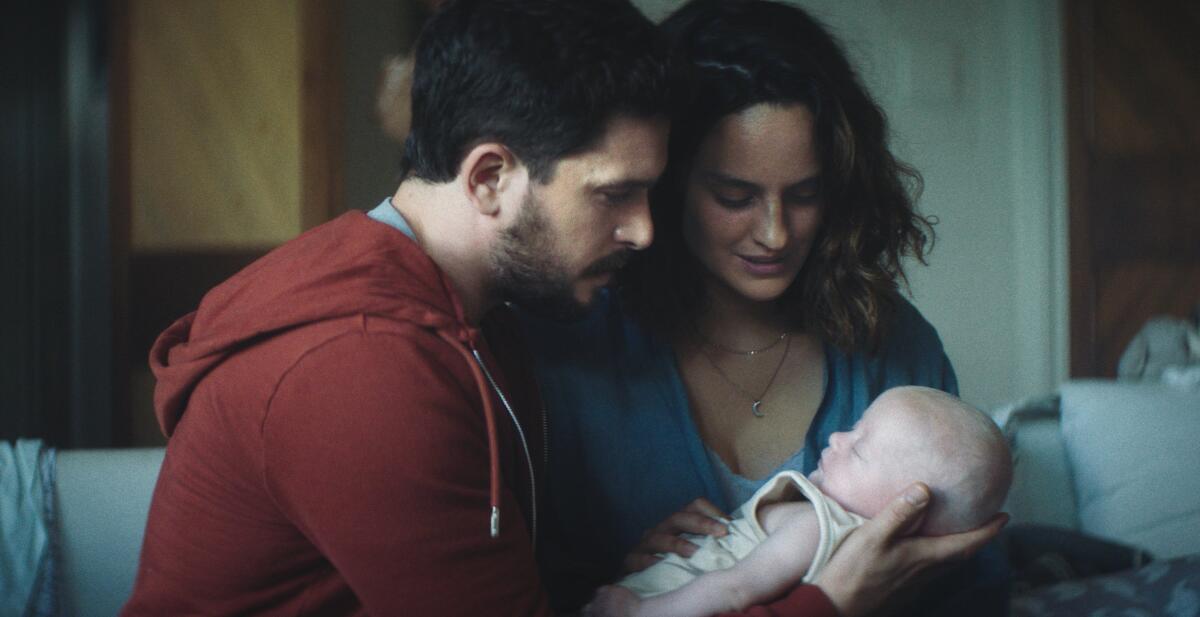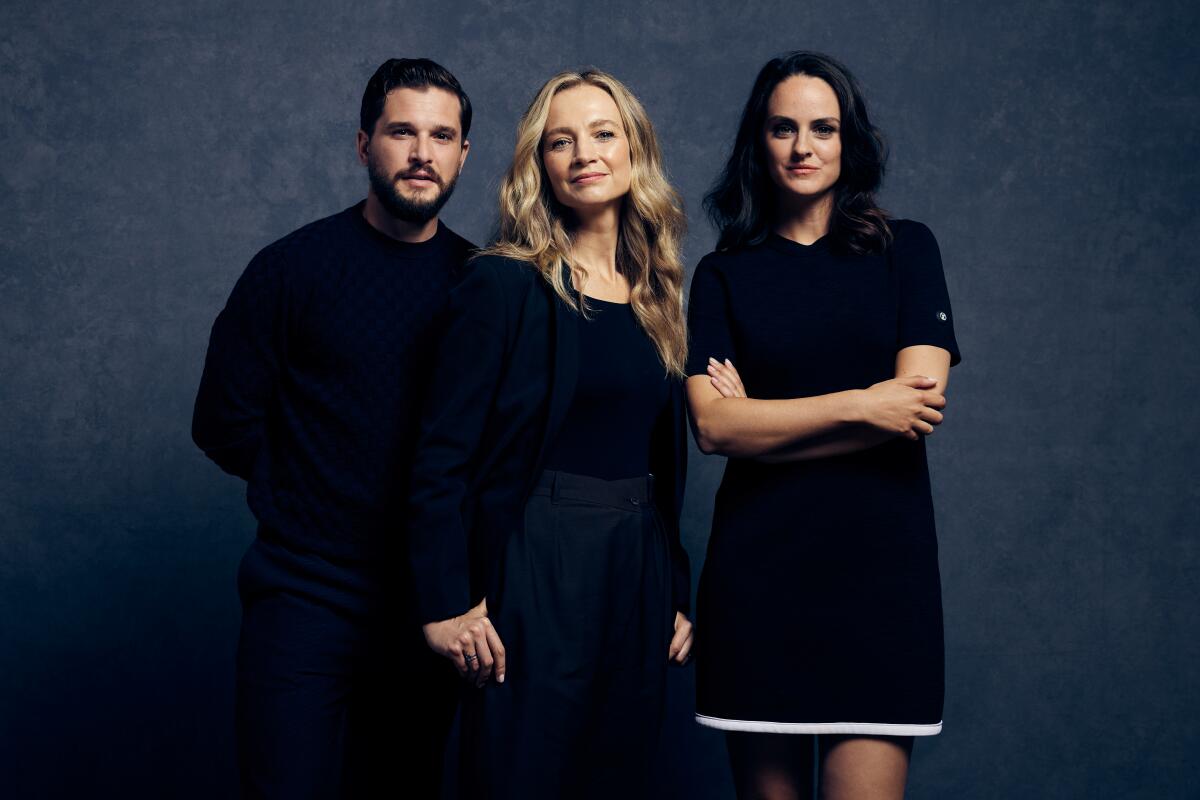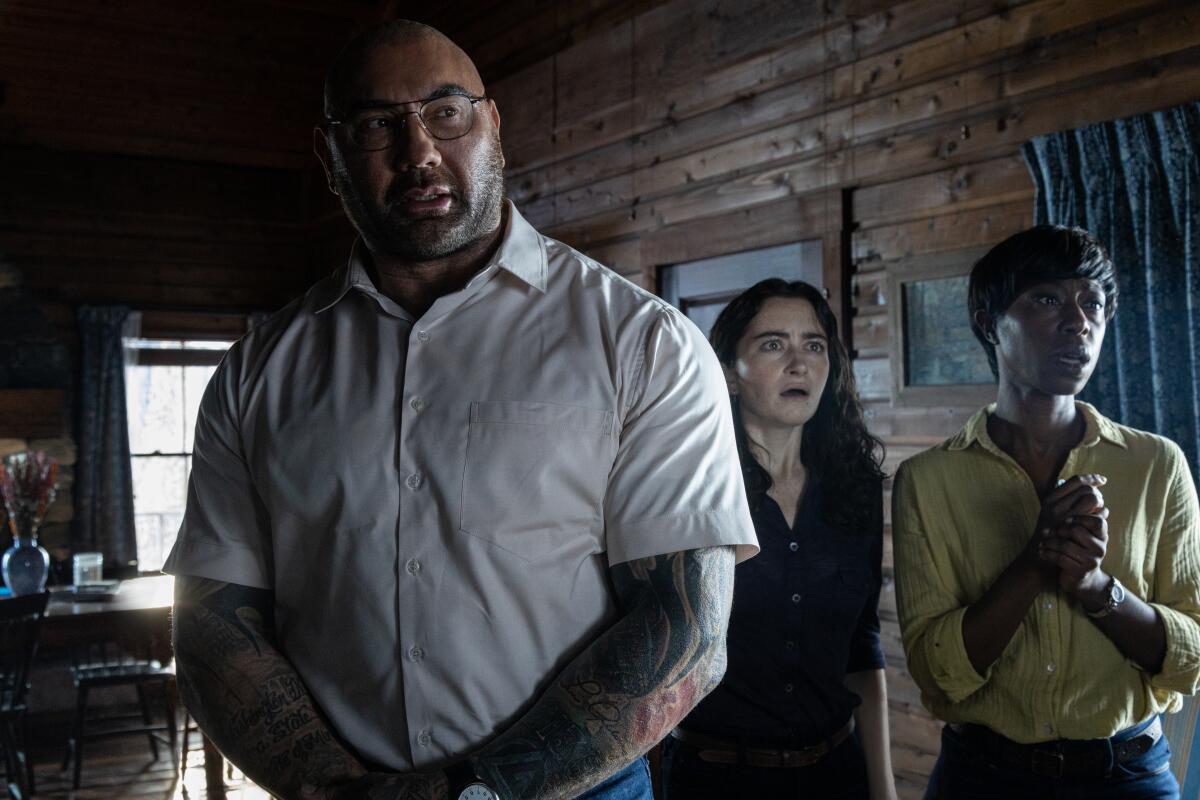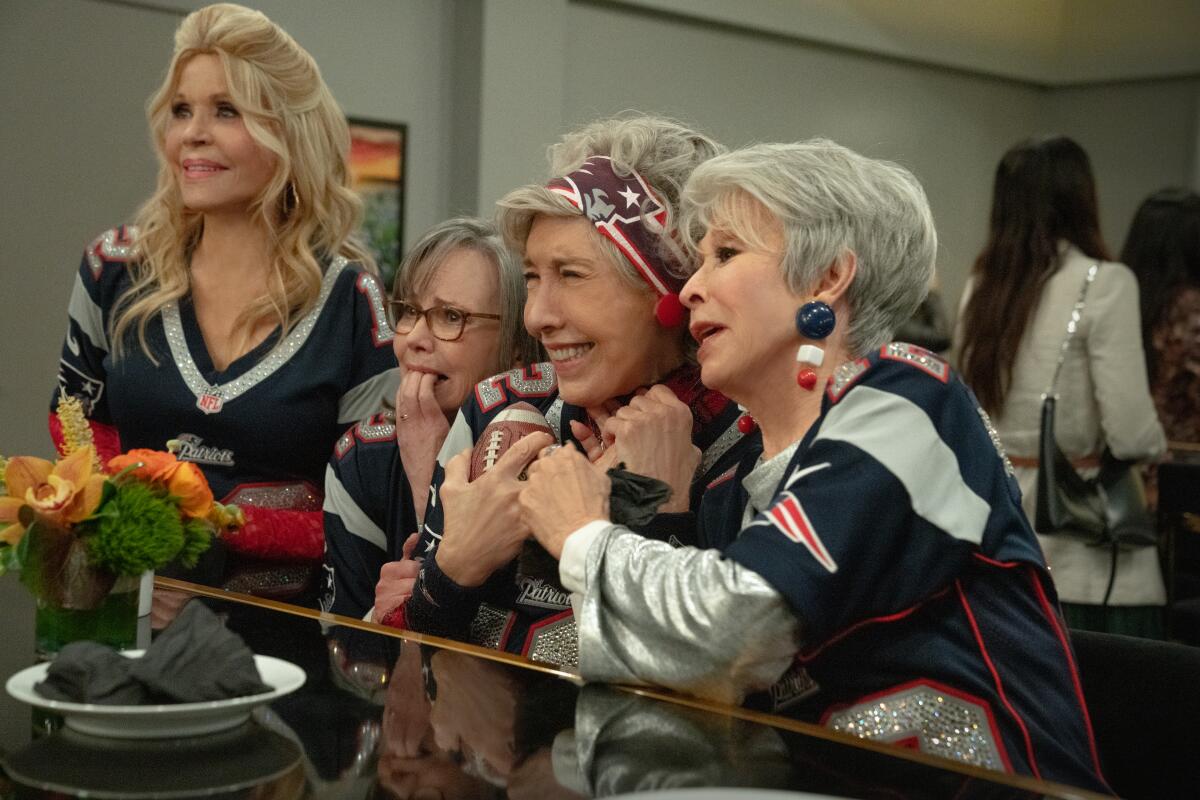The horrors of modern motherhood in ‘Baby Ruby’

- Share via
Hello! I’m Mark Olsen. Welcome to another edition of your regular field guide to a world of Only Good Movies.
Only good movies
Get the Indie Focus newsletter, Mark Olsen's weekly guide to the world of cinema.
You may occasionally receive promotional content from the Los Angeles Times.
“The Conformist” restoration. Bernardo Bertolucci’s 1970 film “The Conformist” returns to theaters in a new 4K restoration. Adapted from a novel by Alberto Moravia, the film is set in 1930s Italy and stars Jean-Louis Trintignant, Stefania Sandrellie and Dominique Sanda in a tale of desire and betrayal. Probably one of the best-looking movies ever made, its production designer was Ferdinando Scafiotti, who would go on to win an Oscar for “The Last Emperor” and also work on films such as “American Gigolo” and “Scarface”, with cinematography by Vittorio Storaro, who would go on to win Oscars for “The Last Emperor,” “Reds” and “Apocalypse Now.”
Introducing a 1971 interview with Bertolucci for Film Comment, Amos Vogel wrote that “it is abundantly clear that Bertolucci’s entire work is permeated by a profound, continuing and as yet unresolved tension between a luxuriant, vibrant aestheticism and a possibly artificial endeavor to simultaneously create a radical, politically committed cinema; this is paralleled in his own life by the tension between bourgeois background and deeply felt ideological preoccupations.”
“The Leopard” 60th anniversary. The American Cinematheque is having a 60th anniversary showing of Luchino Visconti’s 1963 film “The Leopard,” also in the running for one of the most ravishingly beautiful films ever made, this Saturday. With a cast that includes Burt Lancaster, Alain Delon and Claudia Cardinale, the film is based on the novel by Giuseppe Tomasi di Lampedusa and chronicles the end of an era, even as those most impacted may not yet realize their time has passed.
“Millennium Mambo” dances back. The Cinematheque screens a new 4K restoration of Hou Hsiao-Hsien’s 2001 film “Millennium Mambo,” through Feb. 10. Set in Taipei just after Y2K, the story follows a bar hostess Vicky (Shu Qi) as she drifts through the nightlife world. Writing about the rerelease in the New York Times, the critic J. Hoberman said, “The movie has a capital-L look.”
The Cinematheque is also showing Hou’s 1998 film “Flowers of Shanghai,” set amid the city’s brothels in the 1880s, on Feb. 12. Starring Tony Leung, the film has an enveloping, narcotic feel that makes for a stark contrast to the buzzy sensations of “Millennium Mambo.” It is a treat to be able to see them both theatrically so close together.
Enjoying this newsletter? Consider subscribing to the Los Angeles Times
Your support helps us deliver the news that matters most. Become a subscriber.
‘Baby Ruby’
Playwright Bess Wohl makes her movie debut as writer-director with “Baby Ruby.” Jo (Noémie Merlant) is a lifestyle influencer preparing to have her first baby with her husband, Spencer (Kit Harington), and all seems to be going well as they prepare for a blissful, curated experience. But once the baby, named Ruby, is born things veer off-course, with Jo suffering from severe postpartum depression and feeling unable to keep up with the other new mothers in their neighborhood, including the friendly Shelly (Meredith Hagner). Eventually Jo comes to believe that Ruby has turned against her. The movie is in theaters now.
For The Times, Robert Abele wrote, “The signs indicate that we’re in a fertile time for female creators widening the storytelling purview of motherhood to explore its more taboo-busting areas and darker realities, marked by such disparate examples in tone, theme and experience as ‘The Babadook,’ ‘The Lost Daughter,’ and ‘Saint Omer,’ and even eye-opening documentaries about the maternal health system like ‘Aftershock.’ … ‘Baby Ruby’ is a nightmare scenario, for sure: disorienting, tense, funny and scary. Much of its woolly suspense, however, derives from the clever hinge of discerning whether our protagonist is in a horror film with seemingly no escape, or an everyday black comedy for which she simply wasn’t equipped.”
For the New York Times, Natalia Winkelman wrote, “It was once considered taboo to even suggest that new motherhood was not all sunshine onesies and rainbow mobiles, and ‘Baby Ruby’ arrives on a welcome wave of contemporary movies exploring how the joys of child rearing can commingle with misery. Yet the film, directed by Bess Wohl, often defaults to telling us about these emotional states rather than showing them. … Retro visual flair, such as repeat cuts and mirror effects, add some aesthetic interest to Jo’s spiraling. But ‘Baby Ruby’ hardly whimpers, let alone screams.”
For the Washington Post, Ann Hornaday wrote, “Wohl sets Jo up as the kind of shallow, self-absorbed millennial who can serve as the ideal foil for the humbling realities of motherhood. But once the title character arrives on the scene — in a sequence reminding viewers of just how dangerous and traumatic childbirth can be — Jo becomes a much messier character, literally and figuratively. Like such classics as ‘Rosemary’s Baby,’ as well as more recent series like ‘Fleishman Is in Trouble,’ ‘Baby Ruby’ morphs from a social critique of how American society fails women along the entire spectrum of reproduction to a nuanced — and often uncomfortably candid — portrait of a new mother navigating profound anxiety, alienation, self-doubt and barely containable rage.”
For IndieWire, Robert Daniels wrote, “As Jo careens toward violence, Merlant makes this woman’s internal fears, external, in fascinating and uproarious ways. Because, once again, in the eyes of Jo, Ruby is the villain of this movie. And in Merlant’s performance — where her mind, body and soul feel as though they’re about to be ripped apart — you can see her anger rise in tandem with her exhaustion. … By the time of its discomforting, yet hopeful conclusion, Wohl weaves a mystery with so many illusions based in truth, that every fright is haunting and indelible. ‘Baby Ruby’ is an audacious and riveting portrait of maternal life that’ll leave you wailing into the night.”

Enjoying this newsletter? Consider subscribing to the Los Angeles Times
Your support helps us deliver the news that matters most. Become a subscriber.
‘Knock at the Cabin’
Directed and co-written by M. Night Shyamalan, “Knock at the Cabin” is an adaptation of a novel by Paul G. Tremblay. Eric and Andrew (Jonathan Groff and Ben Aldridge) are on vacation at a remote rental cabin with their daughter Wen (Kristen Cui) when a group of four strangers (Dave Bautista, Rupert Grint, Abby Quinn and Nikki Amuka-Bird) arrives at their door with a very disturbing, apocolyptic proposition. The film is in theaters now.
For The Times, Justin Chang wrote, “Like the director’s previous thriller, the graphic-novel adaptation ‘Old,’ ‘Knock at the Cabin’ suggests that Shyamalan, a filmmaker once hailed for his originality, has grown better at identifying his favorite themes and obsessions in stories other than his own. Despite the startling left turns that he and his co-writers Steve Desmond and Michael Sherman have folded into Tremblay’s narrative, it’s refreshing to see Shyamalan find himself, and at least partially subsume his ego, in someone else’s material. He tells a slim, scaled-down story that feels entirely (maybe even too much) in his B-movie wheelhouse, a story about the horror of the unknown, the power of suggestion and the importance of faith.”
For the New York Times, A.O. Scott wrote, “The movie is called ‘Knock at the Cabin’ (the book is called ‘The Cabin at the End of the World’), and the house, with its remote location, floor-to-ceiling bookcases, dark wood paneling and deep cellar, looks like a perfect place to host a horror movie. Is ‘Knock at the Cabin’ one of those? That’s another topic for debate. Shyamalan is sometimes classified as a horror auteur, but the genre label doesn’t always fit with his themes and methods. While this movie is suspenseful and (discreetly) bloody, it is more interested in thoughts and tender sentiments than in fright or shock. … There is a grandiosity here that’s hard to swallow, and a final swell of emotion that isn’t quite earned. For all its skill and cunning, ‘Knock at the Cabin’ is an overwrought quasi-theological melodrama that also manages to be a half-baked thought experiment.”
For Little White Lies, Hannah Strong wrote, “[Shyamalan conveys] a sense of deep urgency, which gives the decision at the film’s core a real sense of grave importance, and his rather radical alterations to the third act of Tremblay’s text actually work well within the context of the story he’s has decided to tell. Shyamalan’s an optimist, see, despite what the macabre tone of so much of his work would have you believe. Films like ‘The Sixth Sense,’ ‘The Village’ and even ‘Split’ are imbued with a belief in human connection and strength. In ‘Knock at the Cabin,’ it’s impressive how much character development the filmmaker packs into a 100-minute runtime, particularly given there are eight players in the cast.”
For Rolling Stone, David Fear wrote, “Whether ‘Knock at the Cabin’ loses steam in its second half will vary from viewer to viewer; as with almost everything about this film, there are on-the-one-hand arguments to be laid out for and against how the movie plays up to its endgame. … What we can say is that Shyamalan wrestles his existential crisis to a standstill, just enough to let a few rays of sunshine pierce the darkness. It’s one’s faith in the folks who share this big blue marble, not fanaticism, that’s potentially on the chopping block here. The jury’s still out on whether the human race has enough humanity left to keep it together. But, Shyamalan suggests, that doesn’t mean you can give up hope.”

‘80 for Brady’
Directed by Kyle Marvin from a script by Sarah Haskins and Emily Halpern, “80 for Brady” is loosely based on the story of four women who were fans of football star Tom Brady and made their way to the Super Bowl. The film stars Jane Fonda, Lily Tomlin, Sally Field and Rita Moreno with a cast that also includes Bob Balaban, Billy Porter, Harry Hamlin, Guy Fieri, Glynn Turman and the actual Tom Brady. The film is in theaters now.
For The Times, Katie Walsh wrote, “ It’s a relief to report that ‘80 for Brady’ has a case of ‘bad trailer,’ and that the resulting film is funnier and more charming than expected. … The comedy isn’t necessarily groundbreaking, and the story beats are almost painfully predictable, but the picture hangs together thanks to this group of legends and the loose, absurdist humor of the screenplay. Marvin has wisely stacked the supporting cast with comedians and celebs to keep things fresh and funny for this quartet to bounce off, and Alex Moffat and Rob Corddry keep up a steady patter of Boston-accented banter as a pair of Patriots commentators who keep us non-football folk following the action.”
For the New York Times, Amy Nicholson wrote, “The more absurd the gag, the better it works. As Trish, a lovelorn author of Rob Gronkowski erotica (sample title: ‘Between a Gronk and a Hard Place’), Fonda finds herself selecting the perfect Barbarella blonde wig for a romance with a debonair jock played by Harry Hamlin. Moreno’s Maura, a widow with a flair for bold jackets, stumbles into a room steeling herself for an orgy only to find a poker table of Guy Fieri clones, a mesmerizing image destined to be painted on velvet and mounted over a plate of nachos. We’re so pleasantly pummeled by silliness that the film comes to feel like a massage. As soon as I roused myself to wonder if the friends would wind up on a Jumbotron, there they were, grinning for the camera. I grinned back.”
For Time, Stephanie Zacharek wrote about the film in the context of other recent movies about older women, most notably “Book Club,” noting, “it’s time to reframe and reclaim these films as part of something bigger that does matter, both in the world of movies and in real life. Some of these films may be better conceived and more artfully directed than others, but that’s beside the point. They’re an expansion of the classic genre known as the women’s film, whose 1930s and ’40s heyday brought us pictures like ‘Stella Dallas,’ ‘Imitation of Life,’ and ‘Now, Voyager,’ movies in which women sometimes suffered dramatically, but were also often re-vitalized with a new sense of self. As we age, nearly all women notice that they become somewhat invisible in the world, but in the golden era of the women’s film, older women really were expected to fade quietly into the wallpaper. Aging actresses would be relegated to playing anonymous matrons and dowager aunties. But the women in ‘80 for Brady’ and ‘Book Club’ want to be seen on their own terms, whatever those might be.”

Only good movies
Get the Indie Focus newsletter, Mark Olsen's weekly guide to the world of cinema.
You may occasionally receive promotional content from the Los Angeles Times.




